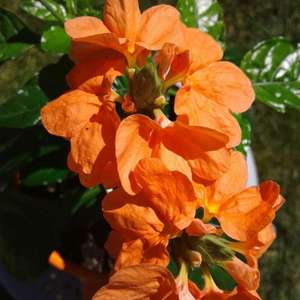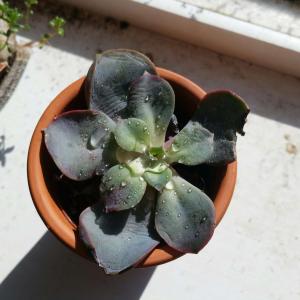成长记
Pommy Mommy
2018年07月21日

I LOVE Hydrangeas! just look how beautiful the colors are and how long flower is in bloom
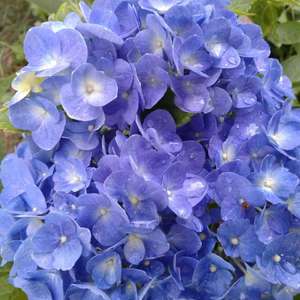
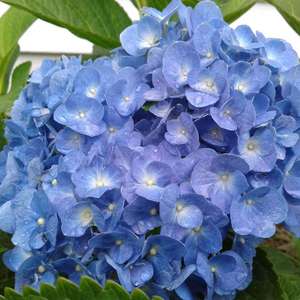
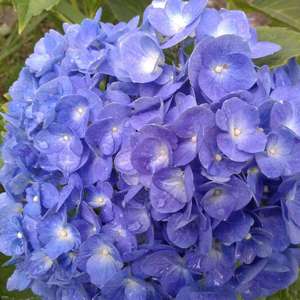
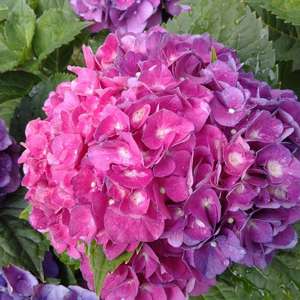
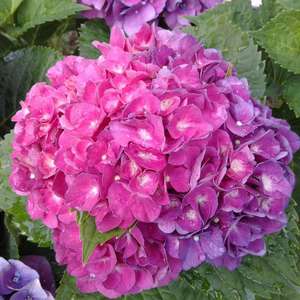
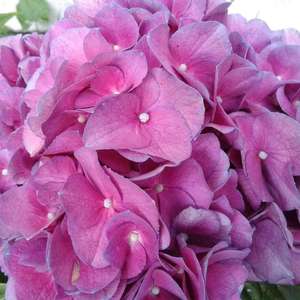
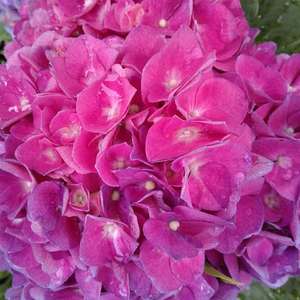
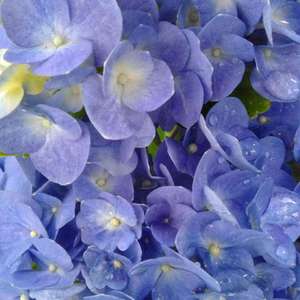








2
0
采元气少女✨:So beautiful.
文章
Miss Chen
2018年07月19日

Pepper plants (Capsicum spp.) are vibrant and beautiful, with their lush foliage and shiny fruit. To grow peppers in your garden, you'll need to know a whole lot more than the fact that Peter Piper picked a peck of them. You'll find a whole host of different sorts of pepper plants available, including exotic spicy peppers as well as the sweet peppers so popular in this country. Fortunately, although the days to maturity differ among pepper species, the basic info on how to grow peppers remains the same.
So Many Peppers, So Little Time

Peppers are tender, warm-season vegetables, like tomatoes. But they don't grow as big and spread as wide as tomato plants do. They also need warmer temperatures and longer time in the garden. The colorful sweet bell pepper varieties (Capsicum annuum) are the most popular in the United States and have been for years. But the vast range of other garden peppers available are gaining traction as essential parts of different ethnic eating experiences. These include chili peppers, cayenne peppers and pimiento peppers. You'll only get the full flavor in any type of peppers if you harvest them at their peak.
Planting Peppers

You get more bang for the buck if you grow peppers from seeds. Start them indoors in late winter, then move them to garden beds after spring works its magic on the temperature of the outdoor air and soil. Transplant the young pepper plants about 18 to 24 inches apart. How many to plant? A dozen plants may provide enough peppers for the average family, but with the incredible variety available, you may want to plant more.
Don't put them outside too early when they could be killed by a frost. They do best when night temperatures stay consistently above 55 degrees Fahrenheit. You can help your young peppers keep their roots warm by transplanting them into raised beds, mulching them well and using floating row covers.
Pepper Care

If you beef up the garden soil before you transplant the peppers, you'll likely have a healthier crop. Be sure the soil is well-drained, and work in organic compost for more fertile soil. Fertilize at the time of transplant, then again after the first peppers are set. Irrigation? It's essential to keep the soil uniformly moist, right up through harvest. Water regularly, especially during dry periods.
When to Pick a Peck

Keep your eyes on the calendar. Time from planting is an important indicator of when your peppers can be harvested. Make a note of when the plants were started. Peppers are generally ripe between 70 to 84 days later, depending in part on the type of peppers.
In most cases, bell peppers approach maturity and are ready to be harvested approximately 70 to 75 days after planting. Bell Boy and Purple Belle are ready in 70 days; Lady Bell in 72 days; Chocolate Bell in 75 days. Note that each of these pepper types changes color when they are ripe, passing from green to red (Bell Boy and Lady Bell), purple to black to red (Purple Bell) and green to brown (Chocolate Bell.) Pick the green-to-red bell peppers when they reach the color you prefer. They get sweeter as they mature, with red being the sweetest stage.
Other sweet types of peppers that you use in salads or for frying, like Gypsy or Sweet Banana, take between 65 and 70 days to mature. These types start yellow, pass to orange, then mature to red.
Hot peppers can take the longest period to ripen. While cayenne and jalapeño peppers are ripe in 70 days, pimientos take 73. And popular chili peppers take 84 days.
The actual harvest itself helps you figure out whether the peppers are ripe. Mature peppers pull off the pepper plants easily. Grasp the pepper, twist and pull to snap it off. If you are sure they're mature, you can use pruners if it is easier.
So Many Peppers, So Little Time

Peppers are tender, warm-season vegetables, like tomatoes. But they don't grow as big and spread as wide as tomato plants do. They also need warmer temperatures and longer time in the garden. The colorful sweet bell pepper varieties (Capsicum annuum) are the most popular in the United States and have been for years. But the vast range of other garden peppers available are gaining traction as essential parts of different ethnic eating experiences. These include chili peppers, cayenne peppers and pimiento peppers. You'll only get the full flavor in any type of peppers if you harvest them at their peak.
Planting Peppers

You get more bang for the buck if you grow peppers from seeds. Start them indoors in late winter, then move them to garden beds after spring works its magic on the temperature of the outdoor air and soil. Transplant the young pepper plants about 18 to 24 inches apart. How many to plant? A dozen plants may provide enough peppers for the average family, but with the incredible variety available, you may want to plant more.
Don't put them outside too early when they could be killed by a frost. They do best when night temperatures stay consistently above 55 degrees Fahrenheit. You can help your young peppers keep their roots warm by transplanting them into raised beds, mulching them well and using floating row covers.
Pepper Care

If you beef up the garden soil before you transplant the peppers, you'll likely have a healthier crop. Be sure the soil is well-drained, and work in organic compost for more fertile soil. Fertilize at the time of transplant, then again after the first peppers are set. Irrigation? It's essential to keep the soil uniformly moist, right up through harvest. Water regularly, especially during dry periods.
When to Pick a Peck

Keep your eyes on the calendar. Time from planting is an important indicator of when your peppers can be harvested. Make a note of when the plants were started. Peppers are generally ripe between 70 to 84 days later, depending in part on the type of peppers.
In most cases, bell peppers approach maturity and are ready to be harvested approximately 70 to 75 days after planting. Bell Boy and Purple Belle are ready in 70 days; Lady Bell in 72 days; Chocolate Bell in 75 days. Note that each of these pepper types changes color when they are ripe, passing from green to red (Bell Boy and Lady Bell), purple to black to red (Purple Bell) and green to brown (Chocolate Bell.) Pick the green-to-red bell peppers when they reach the color you prefer. They get sweeter as they mature, with red being the sweetest stage.
Other sweet types of peppers that you use in salads or for frying, like Gypsy or Sweet Banana, take between 65 and 70 days to mature. These types start yellow, pass to orange, then mature to red.
Hot peppers can take the longest period to ripen. While cayenne and jalapeño peppers are ripe in 70 days, pimientos take 73. And popular chili peppers take 84 days.
The actual harvest itself helps you figure out whether the peppers are ripe. Mature peppers pull off the pepper plants easily. Grasp the pepper, twist and pull to snap it off. If you are sure they're mature, you can use pruners if it is easier.
1
0
成长记
Pommy Mommy
2018年07月12日

I love pansies from seeds! You have no idea what's going to spring up and each one is utterly unique and beautiful!


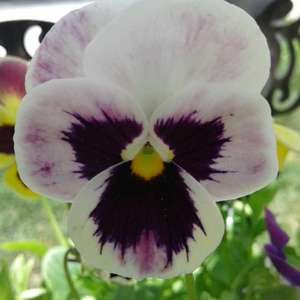





2
0
文章
Miss Chen
2018年07月11日

Haworthia are delightful little succulents that form very attractive and singular small houseplants. Generally easy to grow, the same best practices that yield healthy aloe and echeveria plants will also produce beautiful Haworthia.

In terms of appeal, these small, low growing plants form rosettes of fleshy green leaves that are generously covered with white, pearly warts or bands, giving them a distinctive appearance. Just like other succulents, these plants appreciate bright light, adequate moisture in the summer, and relatively drier conditions in the winter. Avoid overwatering, but don’t let them dry out too much.
Growing Conditions
Light: Bright light, but not direct sunlight. These grow in similar conditions to other succulents. White or yellow leaves usually signify too much sun.
Water: Water evenly and generously in the summer, letting the soil media dry out between waterings. In the winter, reduce watering to every other month. Never allow water to collect in the rosette.
Temperature: Warmer summers but cool in the winter (down to 50 degrees F).
Soil: Use a cactus mix or very fast-draining potting soil mixed with sand.
Fertilizer:Fertilize during the summer growing season with a cactus fertilizer. Don't feed during the winter.
Propagation
Haworthia can be propagated at repotting time using offsets from the mother plant. When taking offsets, use a sharp knife or snippers and cut as close to the mother stem as possible to include as many roots as possible, then allow the offset to dry briefly before repotting it (similar to cuttings from other succulents). Pot the offsets in a small pot, using the same soil as the mother plant, put it in a warm, bright spot, and make sure to adequately water.
Repotting
Haworthia are small (usually remaining between 3" and 5" in height) and relatively slow-growing. They are often grown in small clusters in wide, shallow dishes. Over time, clusters will naturally enlarge as the mother plant sends off small plantlets.
When the cluster has outgrown its dish, repot in the spring or early summer into a new wide and shallow dish with fresh potting soil. This is also the time to take offsets for propagation.

Varieties
There are about 80 species of Haworthia, but their classification can be complex. The main difference between the common species is the size of the leaves and the orientation of the white markings on the leaves. H. margaritifera has warty white projections on the leaves, while H. fasciata features horizontal white stripes and is sometimes called the zebra plant.
Some of the species, such as H. bolusii have "tufted" edges to the leaves, while H. attenuata features long, pointed green leaves. In general, the best advice is to buy the most attractive variety based on leaf form and markings, as they all have similar cultural requirements.
Grower's Tips
Haworthia are not considered difficult houseplants to grow—if you can keep a pot of aloe alive on a windowsill, chances are you can do the same with a dish of Haworthia. As with all succulents, the most dangerous situation is too much water, since they should never be allowed to sit in water under any circumstances.
At the same time, these little decorative plants can be grown in interesting containers such as teacups and even miniature baby shoes. If you're given a Haworthia in such a container, make sure the container had adequate drainage. If it doesn't, it might be a good idea to pop the plant out of its container and add a layer of gravel to the bottom to reduce the wicking action of the soil above.
Finally, look out for sunburned spots on your plants.

In terms of appeal, these small, low growing plants form rosettes of fleshy green leaves that are generously covered with white, pearly warts or bands, giving them a distinctive appearance. Just like other succulents, these plants appreciate bright light, adequate moisture in the summer, and relatively drier conditions in the winter. Avoid overwatering, but don’t let them dry out too much.
Growing Conditions
Light: Bright light, but not direct sunlight. These grow in similar conditions to other succulents. White or yellow leaves usually signify too much sun.
Water: Water evenly and generously in the summer, letting the soil media dry out between waterings. In the winter, reduce watering to every other month. Never allow water to collect in the rosette.
Temperature: Warmer summers but cool in the winter (down to 50 degrees F).
Soil: Use a cactus mix or very fast-draining potting soil mixed with sand.
Fertilizer:Fertilize during the summer growing season with a cactus fertilizer. Don't feed during the winter.
Propagation
Haworthia can be propagated at repotting time using offsets from the mother plant. When taking offsets, use a sharp knife or snippers and cut as close to the mother stem as possible to include as many roots as possible, then allow the offset to dry briefly before repotting it (similar to cuttings from other succulents). Pot the offsets in a small pot, using the same soil as the mother plant, put it in a warm, bright spot, and make sure to adequately water.
Repotting
Haworthia are small (usually remaining between 3" and 5" in height) and relatively slow-growing. They are often grown in small clusters in wide, shallow dishes. Over time, clusters will naturally enlarge as the mother plant sends off small plantlets.
When the cluster has outgrown its dish, repot in the spring or early summer into a new wide and shallow dish with fresh potting soil. This is also the time to take offsets for propagation.

Varieties
There are about 80 species of Haworthia, but their classification can be complex. The main difference between the common species is the size of the leaves and the orientation of the white markings on the leaves. H. margaritifera has warty white projections on the leaves, while H. fasciata features horizontal white stripes and is sometimes called the zebra plant.
Some of the species, such as H. bolusii have "tufted" edges to the leaves, while H. attenuata features long, pointed green leaves. In general, the best advice is to buy the most attractive variety based on leaf form and markings, as they all have similar cultural requirements.
Grower's Tips
Haworthia are not considered difficult houseplants to grow—if you can keep a pot of aloe alive on a windowsill, chances are you can do the same with a dish of Haworthia. As with all succulents, the most dangerous situation is too much water, since they should never be allowed to sit in water under any circumstances.
At the same time, these little decorative plants can be grown in interesting containers such as teacups and even miniature baby shoes. If you're given a Haworthia in such a container, make sure the container had adequate drainage. If it doesn't, it might be a good idea to pop the plant out of its container and add a layer of gravel to the bottom to reduce the wicking action of the soil above.
Finally, look out for sunburned spots on your plants.
2
4
文章
Miss Chen
2018年07月10日

Succulents seem custom-made for indoor gardeners. These hardy plants can thrive for long periods in poor conditions. But given proper care, succulents are some of the most beautiful plants in the world. Learn how to care for succulents plus a few varieties we love.

01How to Grow Healthy Succulents
Succulents are some of the most rewarding plants for indoor gardeners. They're tough, beautiful, and have interesting and varied foliage. Read our best tips for caring for these plants.

02Growing Aloe
Aloe is one of the most popular succulents, grown for both its beauty and health benefits.

03Growing Desert Rose (Adenium obesum)
Desert rose is a striking plant with beautiful flowers. Beware the sap, however, which can be caustic.

04Growing Sedum Morganianum (Burro's Tail)
These beautiful succulents are trailing plants that form long, striking "tails" of tear-drop shaped leaves.

05Growing Echeveria
One of the more popular varieties, Echeveria succulents grow in tight rosettes of overlapping leaves. They are perfect indoor plants: small, beautiful and easy to care for.

01How to Grow Healthy Succulents
Succulents are some of the most rewarding plants for indoor gardeners. They're tough, beautiful, and have interesting and varied foliage. Read our best tips for caring for these plants.

02Growing Aloe
Aloe is one of the most popular succulents, grown for both its beauty and health benefits.

03Growing Desert Rose (Adenium obesum)
Desert rose is a striking plant with beautiful flowers. Beware the sap, however, which can be caustic.

04Growing Sedum Morganianum (Burro's Tail)
These beautiful succulents are trailing plants that form long, striking "tails" of tear-drop shaped leaves.

05Growing Echeveria
One of the more popular varieties, Echeveria succulents grow in tight rosettes of overlapping leaves. They are perfect indoor plants: small, beautiful and easy to care for.
1
2
文章
Miss Chen
2018年06月23日

Succulents are booming in popularity for two simple reasons: they are beautiful and nearly indestructible.
Technically, a succulent is any plant with thick, fleshy (succulent) water storage organs. Succulents store water in their leaves, their stems or their roots. These plants have adapted to survive arid conditions throughout the world, from Africa to the deserts of North America. Fortunately for us, this adaptive mechanism has resulted in an incredible variety of interesting leaf forms and plant shapes, including paddle leaves, tight rosettes, and bushy or trailing columns of teardrop leaves.

As a group, succulents include some of the most well-known plants, such as the aloe and agave, and many almost unknown plants. Cacti are a unique subset of the succulent group. Succulents make excellent display plants in dish gardens.
The Rules for Growing Succulent Houseplants
No matter what kind of succulent you're growing, the rules are pretty similar between the different species. Here are the general rules for growing top-quality succulents:
Southern Light
Succulents prefer bright light, such as found on a south-facing window. Watch the leaves for indications that the light level is correct. Some species will scorch if suddenly exposed to direct sunlight. The leaves will turn brown or white as the plant bleaches out and the soft tissues are destroyed. Alternatively, an underlit succulent will begin to stretch, with an elongated stem and widely spaced leaves. This condition is known as etoliation.
The solution is to provide better light and prune the plant back to its original shape. Many kinds of succulents will thrive outdoors in the summer.
Temperature
Succulents are much more cold-tolerant than many people assume. As in the desert, where there is often a marked contrast between night and day, succulents thrive in colder nights, down to even 40ºF.
Ideally, succulents prefer daytime temperatures between 70 F and about 85 F and nighttime temperatures between 50 F and 55 F.
Watering
Succulents should be watered generously in the summer. The potting mix should be allowed to dry between waterings, but do not underwater. During the winter, when the plants go dormant, cut watering back to once every other month. Overwatering and ensuing plant rot is the single most common cause of plant failure. Be aware, though, that an overwatered succulent might at first plump up and look very healthy. However, the cause of death may have already set in underground, with rot spreading upward from the root system. A succulent should never be allowed to sit in water. The following are signs of under- or overwatering:
Overwatering. Overwatered plants are soft and discolored. The leaves may be yellow or white and lose their color. A plant in this condition may be beyond repair, but you can still remove it from its pot and inspect the roots. If they are brown and rotted, cut away dead roots and repot into drier potting media, or take a cutting and propagate the parent plant.
Under-watering: Succulents prefer generous water during the growing season (spring and summer). An under-watered plant will first stop growing, then begin to shed leaves. Alternatively, the plant may develop brown spots on the leaves.
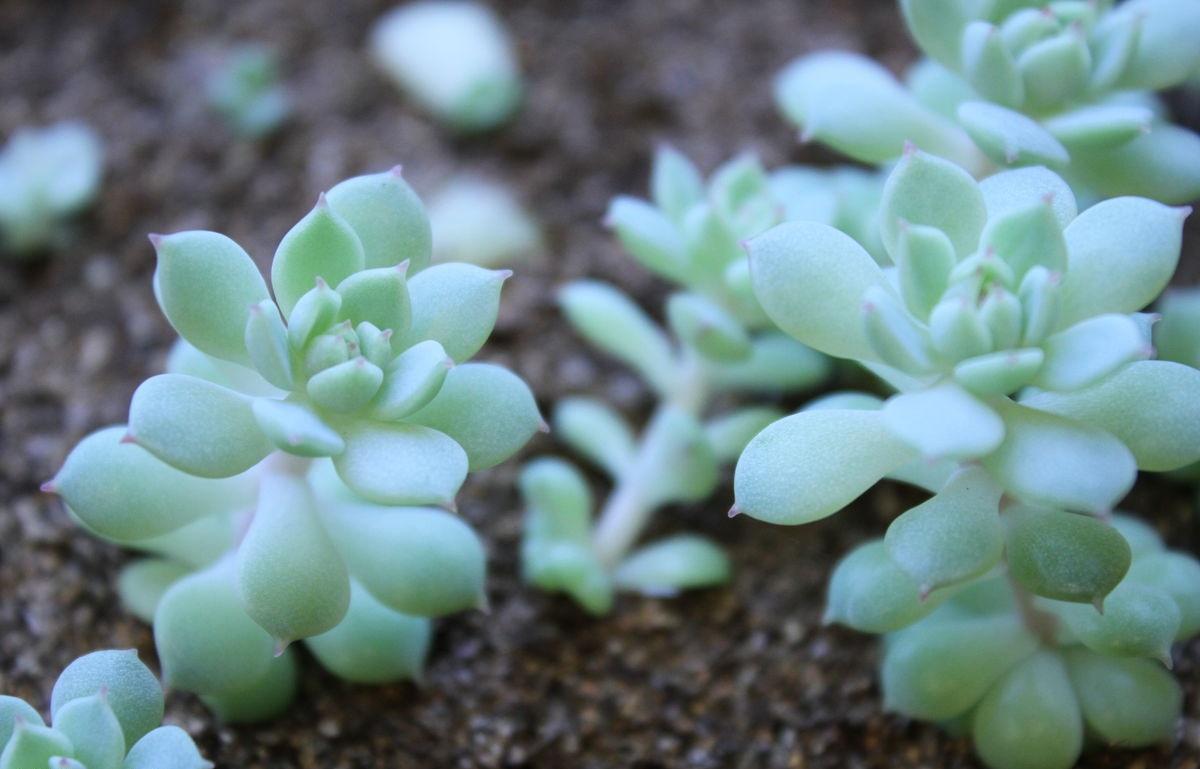
Potting Soil
Succulents should be potted in a fast-draining mixture that's designed for cacti and succulents. If you don't have access to a specialized mix, consider modifying a normal potting mix with an inorganic agent like perlite to increase aeration and drainage. These plants have shallow roots that form a dense mat just under the soil surface.
Fertilizer
During the summer growing season, fertilizer as you would with other houseplants. Stop fertilizing entirely during the winter.
Technically, a succulent is any plant with thick, fleshy (succulent) water storage organs. Succulents store water in their leaves, their stems or their roots. These plants have adapted to survive arid conditions throughout the world, from Africa to the deserts of North America. Fortunately for us, this adaptive mechanism has resulted in an incredible variety of interesting leaf forms and plant shapes, including paddle leaves, tight rosettes, and bushy or trailing columns of teardrop leaves.

As a group, succulents include some of the most well-known plants, such as the aloe and agave, and many almost unknown plants. Cacti are a unique subset of the succulent group. Succulents make excellent display plants in dish gardens.
The Rules for Growing Succulent Houseplants
No matter what kind of succulent you're growing, the rules are pretty similar between the different species. Here are the general rules for growing top-quality succulents:
Southern Light
Succulents prefer bright light, such as found on a south-facing window. Watch the leaves for indications that the light level is correct. Some species will scorch if suddenly exposed to direct sunlight. The leaves will turn brown or white as the plant bleaches out and the soft tissues are destroyed. Alternatively, an underlit succulent will begin to stretch, with an elongated stem and widely spaced leaves. This condition is known as etoliation.
The solution is to provide better light and prune the plant back to its original shape. Many kinds of succulents will thrive outdoors in the summer.
Temperature
Succulents are much more cold-tolerant than many people assume. As in the desert, where there is often a marked contrast between night and day, succulents thrive in colder nights, down to even 40ºF.
Ideally, succulents prefer daytime temperatures between 70 F and about 85 F and nighttime temperatures between 50 F and 55 F.
Watering
Succulents should be watered generously in the summer. The potting mix should be allowed to dry between waterings, but do not underwater. During the winter, when the plants go dormant, cut watering back to once every other month. Overwatering and ensuing plant rot is the single most common cause of plant failure. Be aware, though, that an overwatered succulent might at first plump up and look very healthy. However, the cause of death may have already set in underground, with rot spreading upward from the root system. A succulent should never be allowed to sit in water. The following are signs of under- or overwatering:
Overwatering. Overwatered plants are soft and discolored. The leaves may be yellow or white and lose their color. A plant in this condition may be beyond repair, but you can still remove it from its pot and inspect the roots. If they are brown and rotted, cut away dead roots and repot into drier potting media, or take a cutting and propagate the parent plant.
Under-watering: Succulents prefer generous water during the growing season (spring and summer). An under-watered plant will first stop growing, then begin to shed leaves. Alternatively, the plant may develop brown spots on the leaves.

Potting Soil
Succulents should be potted in a fast-draining mixture that's designed for cacti and succulents. If you don't have access to a specialized mix, consider modifying a normal potting mix with an inorganic agent like perlite to increase aeration and drainage. These plants have shallow roots that form a dense mat just under the soil surface.
Fertilizer
During the summer growing season, fertilizer as you would with other houseplants. Stop fertilizing entirely during the winter.
0
1
文章
Miss Chen
2018年06月23日

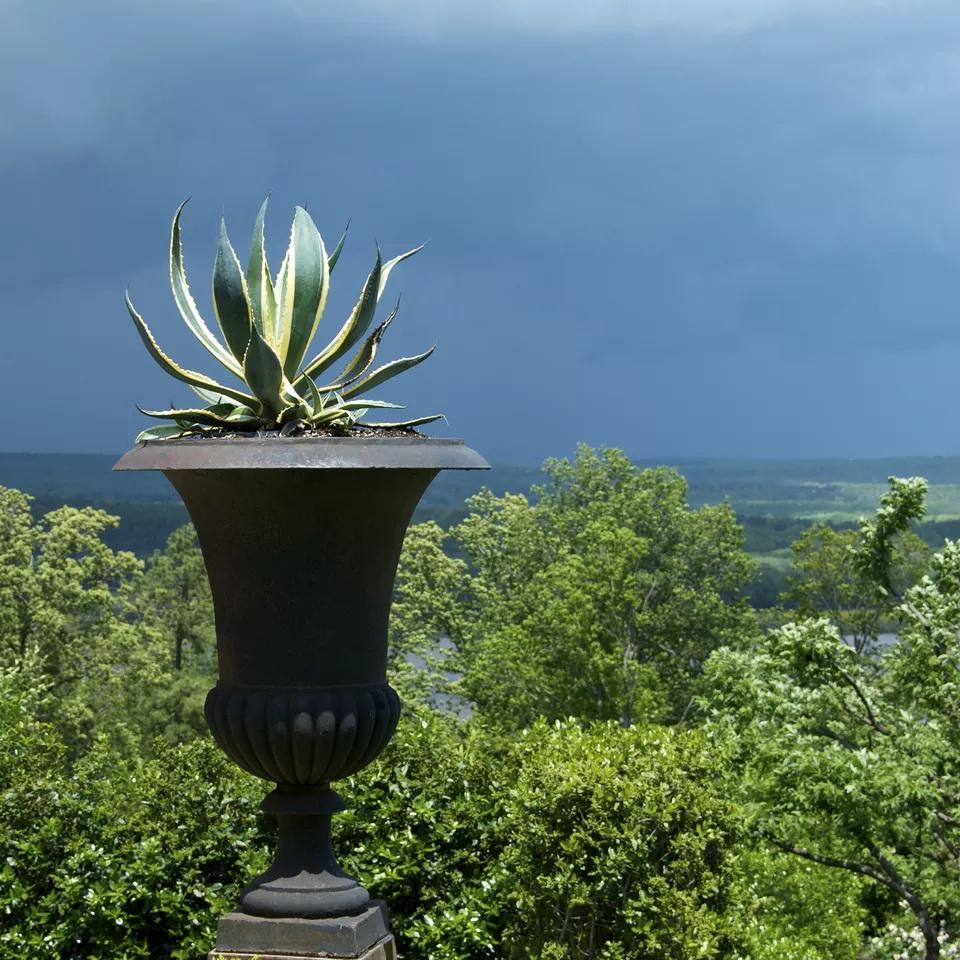
1.Agave in a Garden Pot
Succulent plants make great, easy container garden plants.
Succulent are one of my favorite container garden plants. They are low-maintenance, beautiful and they come in stunning colors, many different sizes, textures and shapes.
I am somewhat in awe of agaves. They are beautiful, striking and somewhat lethal, given their spikes, sharp tips and potentially toxic sap. Despite their seemingly hostile appearance they are fairly good-natured plants - not difficult to care for and tolerant of cool temperatures. Though they prefer hot, full sun, agaves will tolerate some shade.
P. Allen Smith uses agaves to great dramatic affect. Potted in large, dark containers, they punctuate the landscape and add a modern, sculptural sensibility as well as vertical interest.

2.Succulents on the Half Shell
These clamshells are packed full of succulent plants. They can be used for table decorations and make great house presents. You can use a mix of succulent plants, or use one type. These are planted with a few different kinds of hens and chicks, and some tiny echeverias.
As when planting any succulent, use either a potting soil made specifically for succulents and cacti, or make your own by taking a good quality potting mix and adding either pumice or perlite. Make sure to use a container that either has drainage holes one that you can punch or drill holes in. Drainage is key to keeping your succulents healthy.
To care for these miniature container gardens, give them full sun, or if you are in a very hot climate, keep them in partial shade. Do not over-water. During the growing season, keep the soil moist, but not wet. During the winter, when succulents go into dormancy, let the soil dry out between waterings.
Hens and chicks are incredibly forgiving plants. They are extremely hardy - most of them can survive in zone 3, and can tolerate poor soil.
For Step by step instructions on making clam shell container gardens.

3.Succulents in a Lunchbox
You can plant succulents in almost anything. Because of their shallow root structure, you don't need a very deep pot. You do need good drainage though. I took a large nail and hammered so many holes in the bottom of this box, that by the time I was done, it looked like Swiss cheese.
Because the metal is pretty thin, I made sure to punch the holes with the metal sitting directly on the ground, so it wouldn't bend the box.
After I punched the holes, I lined the box with plastic also with holes, so it wouldn't rust as quickly. I then filled it with a potting mix specifically designed for cacti and succulents. I packed the box full of plants, putting the ones that I knew would drape, near the edges, and the larger plants near the back.
The box sits in full sun, and I water it enough to keep the soil moist, but not wet. I'll bring it inside in the late fall and keep it in bright, indirect light. In the winter I'll let the soil dry out completely between waterings.
0
0
成长记
Pommy Mommy
2018年06月11日

I now added "Petunia (beautiful but sticky to deadhead)" in my "garden"
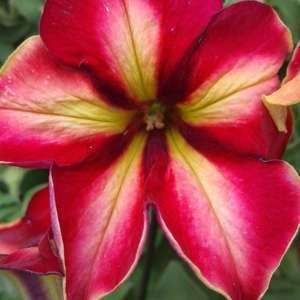

0
0
文章
Miss Chen
2018年04月15日

Don't let the name fool you. There's nothing sour or citrusy about the flavor of lemon cucumbers. The name comes from the beautiful yellow skin on these uniquely shaped heirloom cucumbers. These round cucumbers have a mild, slightly sweet flavor, and they're much smaller than traditional cucumbers, so they're ideal for snacking. Growing lemon cucumbers is very similar to traditional cucumbers. Knowing when to pick them helps you enjoy the peak of their flavor and ripeness.

Time to Maturity
Lemon cucumbers grow fairly quickly. They mature in roughly 60 to 75 days from seed. The seeds take roughly five to 10 days to germinate. More cucumbers grow as you harvest them, so it's best to start picking them as soon as they mature. Lemon cucumbers have a range of time when they taste good, so you don't have to watch the calendar closely and pick it only at a certain time.
Signs of Maturity
Timing isn't the only factor when it comes to deciding when to harvest lemon cucumbers. Look for signs of maturity in the cucumbers themselves before deciding to harvest. The longer you wait to pick the cucumbers, the thicker the skin becomes and the larger the seeds grow. An overly ripe harvest can also taste bitter.
Ripe lemon cucumbers measure between 2 and 3 inches long. Estimate a 2-inch cucumber as roughly the size of an egg. The skin and seeds are edible at that size, although the cucumbers aren't considered fully ripe until they're closer to 3 inches, or roughly the size of a tennis ball. Anything larger is likely too ripe.
The skin color is another clue that it's time to harvest. As they ripen, the skin turns from green to light yellow to dark yellow. Pick them when they're just starting to turn yellow. If the ends are yellow, it's a sign they're overripe. Dark yellow skin also means you've waited a little too long to harvest. The cucumbers are still edible, but you may not like the thicker skin and more bitter flavor.

Tips for Harvesting Lemon Cucumbers
Harvesting the ripe cucumbers is easy. Snip the stem just above the fruit using a clean knife or scissors. It's a good idea to check the plants each day, as the cucumbers grow quickly. If you wait more than a day to check, you may discover several of them are overly ripe.
Lemon cucumbers don't last long when harvested, so pick only what you can eat soon. At room temperature, they usually last a day or two until shriveling starts. They tend to last longer at room temperature than they do in the refrigerator, so it's better to leave them on the counter than to store them in the fridge. Pickling the lemon cucumbers is a way to make them last longer.

Time to Maturity
Lemon cucumbers grow fairly quickly. They mature in roughly 60 to 75 days from seed. The seeds take roughly five to 10 days to germinate. More cucumbers grow as you harvest them, so it's best to start picking them as soon as they mature. Lemon cucumbers have a range of time when they taste good, so you don't have to watch the calendar closely and pick it only at a certain time.
Signs of Maturity
Timing isn't the only factor when it comes to deciding when to harvest lemon cucumbers. Look for signs of maturity in the cucumbers themselves before deciding to harvest. The longer you wait to pick the cucumbers, the thicker the skin becomes and the larger the seeds grow. An overly ripe harvest can also taste bitter.
Ripe lemon cucumbers measure between 2 and 3 inches long. Estimate a 2-inch cucumber as roughly the size of an egg. The skin and seeds are edible at that size, although the cucumbers aren't considered fully ripe until they're closer to 3 inches, or roughly the size of a tennis ball. Anything larger is likely too ripe.
The skin color is another clue that it's time to harvest. As they ripen, the skin turns from green to light yellow to dark yellow. Pick them when they're just starting to turn yellow. If the ends are yellow, it's a sign they're overripe. Dark yellow skin also means you've waited a little too long to harvest. The cucumbers are still edible, but you may not like the thicker skin and more bitter flavor.

Tips for Harvesting Lemon Cucumbers
Harvesting the ripe cucumbers is easy. Snip the stem just above the fruit using a clean knife or scissors. It's a good idea to check the plants each day, as the cucumbers grow quickly. If you wait more than a day to check, you may discover several of them are overly ripe.
Lemon cucumbers don't last long when harvested, so pick only what you can eat soon. At room temperature, they usually last a day or two until shriveling starts. They tend to last longer at room temperature than they do in the refrigerator, so it's better to leave them on the counter than to store them in the fridge. Pickling the lemon cucumbers is a way to make them last longer.
0
0








